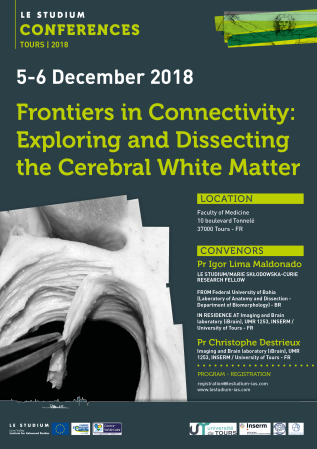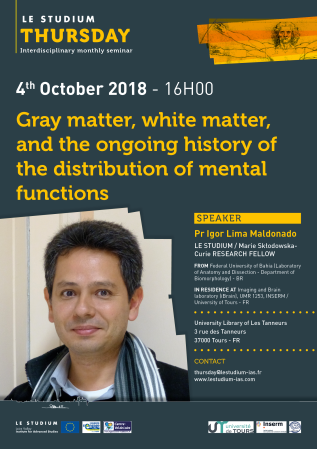Prof. Igor Lima Maldonado

From
In residence at
Imaging and Brain laboratory (iBrain), INSERM / University of Tours - FR
Host scientist
Prof. Christophe Destrieux
PROJECT
Characterization of Limbic System Connectivity through fiber dissection and diffusion imaging techniques
BACKGROUND AND AIM
Although cortical elements of the limbic system are quite well defined, the underlying white matter pathways are not well detailed. This research project aims to better describe white matter tracts of the limbic system using both fiber dissection, and in and ex vivo Diffusion Weighted Imaging (DWI) techniques at various spatial resolutions. This multiple approach will: (1) improve the current anatomical knowledge on limbic connectivity; (2) validate in and ex vivo tractography by comparison to fiber dissection considered as a ground truth; (3) describe functional roles of limbic white mater tracts by studying correlations between neuropsychological alterations and microstructural changes examined by DWI.
METHODS
a) in vivo data (from DWI and neuropsychological evaluations) will be obtained from 60 healthy subjects aged 82 and over previously enrolled in the FIBRATLAS project funded by the French Research Agency (ANR) and run in the host laboratory. Correlations between neuropsychological and white matter alterations studied on DWI will be examined in this group and will infer the function of the limbic white matter tracts (aim #3).
b) ex vivo data obtained from 30 cadavers will be examined: three of them obtained from volunteers previously included in the FIBRATLAS project and who will die during this proposal; and other 27 obtained from the Tours Body Donation Program. The brains will be extracted, fixed in formalin and used to study the anatomy of the limbic white matter tracts (aim #1) employing the following methods:
- Ex vivo DWI using two different clinical scanners equipped with coils, sequences and gradients adapted for imaging at magnetic fields of 3T and 7T.
- Ex vivo DWI in a preclinical scanner (11.7T) equipped with gradients allowing a very high diffusion weighting.
- Dissection according to a variant of the Klingler’s method developed by the host laboratory, to reconstruct fiber tracts into the MRI reference space. Comparison of in and ex vivo DWI data obtained for the same subjects will compose a validation study of tractography (aim #2).
Publications
The insula was for a long time considered as one of the most challenging areas of the brain. This is mainly related to its location, deep and medial to the frontoparietal, temporal, and fronto-orbital opercula. Another difficulty is the content of the lateral fossa, located between the insula and the opercula, which contains the trunks, stem, arteries, and cortical branches of the insular (M2) and opercular (M3) segments of the middle cerebral artery (MCA). Finally, the insula is surrounded by several white matter tracts and cortical structures having important functional roles, especially for language in the dominant hemisphere; the insula is indeed located between a dorsal phonological stream, centered by the arcuate fasciculus and lateral to the posterior insula, and a ventral semantic system, medial to the ventral aspect of the insula and centered by the inferior fronto-occipital fasciculus (IFOF). This chapter reviews some of these surgically relevant anatomical relationships.
When the lips of the lateral fissure are separated from each other, a new group of sulci and gyri appear. They are arrayed together in the form of an island, which is the reason why the German anatomist, Johann Christian Reil, named them “the insular lobe”. Bordered by the limiting sulci, its general form resembles that of an oblique pyramid with a triangular base and low height. Although some anatomical variation exists, the insula presents a systematizable internal organization and well-defined anatomical relationships with deep and superficial cerebral structures, such as the extreme capsule and the cerebral opercula. In this chapter we review concepts of the insular morphology that are important to the fields of neurosurgery and neuroimaging.
Although the middle longitudinal fasciculus (MdLF) is not part of the insular lobe, it penetrates the temporal operculum, which is manipulated or partially removed during surgical approaches to the insula. We present a comprehensive description of that fascicle and its anatomical relationships with neighboring structures that have been described in previous chapters. It has been hypothesized that MdLF plays a role in attention and language processing; however studies with peroperative subcortical electrostimulation or temporal lobectomies did not demonstrate permanent language deficits following resection of its anterior segment. The MdLF has close relationships to adjacent bundles, such as the arcuate fasciculus and the inferior fronto-occipital fasciculus that are required to be recognized and differentiated for adequate interpretation of tractography images and surgical planning.
Aim of the study: To assess a program combining virtual reality (VR) games and proprioceptive neuromuscular facilitation (PNF), and to compare it to the standalone techniques in stroke survivors. Methods: A randomized controlled clinical trial. Forty-eight participants were recruited in the outpatient clinic of a University Hospital in Salvador, Brazil. They were randomly assigned to three groups (n=16 each): PNF, VR, and PNF/VR. Participants attended twice-weekly fifty-minute sessions over a two-month period. The PNF/VR group performed both PNF and virtual reality exercises employing Nintendo Wii electronic games. Motor performance was assessed before and immediately after the treatment using the Fugl-Meyer Assessment scale. Results: Improvement in the mean scores was observed after treatment independent of the allocation group with significant intra-group changes: 14.5, 10.5, and 10.4 for PNF, VR and PNF/VR, respectively. Score changes were also observed in the analyses of specific sections as follows: (1) A significant improvement in the passive movement and pain score was observed in the PNF and PNF/VR groups. (2) The same was observed for the motor function of the upper limb in all groups, for the motor function of the lower limb in the VR group and for balance in the PNF and PNF/VR groups. Conclusion: The use of a program combining virtual rehabilitation and PNF presented results that were comparable to those obtained with the isolated techniques
Objective To present an adaptation of the anaglyph photography technique to be used with radiological images from computed tomography angiograms, enabling stereoscopic visualization of a patient's individual abnormal vascular anatomy for teaching, case discussion, or surgical planning purposes. Methods Traditional anaglyph procedures with actual objects yield 2 independent photographs, simulating the image perceived by each eye. Production of anaglyphs from angiograms involve 3 basic procedures: volume rendering, image capture, and image fusion. Volume renderings were reconstructed using a free, open-source DICOM (Digital Imaging and Communications in Medicine) reader. Subsequently, the virtual object was positioned to mimic the operator's angle of view, and different perspectives of the reconstructed volume could be obtained through exclusively horizontal rotation. The 2 images were then fused after their color composition was modified so that each eye would perceive only 1 image when using anaglyph glasses. Results Forty-three angiograms were reviewed for the purpose of this study and a total of 6 examinations were selected for illustration of the technique. Stereoscopic display was possible for all of them and in the 3 types of support tested: computer monitor, tablet, and smartphone screens. Conclusions Anaglyph display of computed tomography angiograms is an effective and low-cost alternative for the stereoscopic visualization of a patient's individual intracranial vascular anatomy.
INTRODUCTION:Although the role of trunk exercises in the chronic phase of stroke is acknowledged, the addition of specific inpatient training in the subacute stage is a matter of debate and varies among centers. Recent new evidence suggests the question should be revisited. OBJECTIVE:To assess the impact of the addition of specific trunk training to inpatient rehabilitation protocols after a recent stroke. METHODS:A systematic review was performed assessing the impact of inpatient trunk training. The search was performed in LILACS, SciELO, PEDro, Cochrane, and NCBI PubMed databases for clinical trials published up to December 31st, 2017. The initial bibliographic research identified 3202 articles. After analyzing the titles, 19 abstracts were selected for detailed analysis. After application of the eligibility criteria, the final selection included nine studies. Outcome measurements from the same evaluation instruments were submitted to a meta-analysis to improve homogeneity (7 studies). RESULTS:All patients in the included studies were recruited less than three months after a stroke. Seven studies assessed trunk control using the Trunk Impairment Scale (TIS). There was a significant improvement in trunk control with a pooled increase in TIS score of 3.3 points from the baseline (CI95:2.54–4.06, p < 0.0001). Three studies assessed balance using the Brunel Balance Assessment (BBA) scale. There was also a significant improvement in balance with a pooled increase in BBA score of 2.7 points (CI95:1.5–4.03, p < 0.0001). The Berg Balance Scale was used for balance assessment in three studies. The meta-analysis of their results showed a pooled increase of 13.2 points (CI95:9.49–16.84, p < 0.0001). Weight transfer was evaluated in four studies using different methods. The addition of inpatient trunk exercises was associated with an improvement in the ability to transfer the trunk laterally in three studies. CONCLUSION:The introduction of trunk-based inpatient training protocols brings short-term benefits in trunk performance and balance in stroke patients.
Glioblastoma Multiforme (GBM) invasiveness renders complete surgical resection impossible and highly invasive Glioblastoma Initiating Cells (GICs) are responsible for tumour recurrence. Their dissemination occurs along pre-existing fibrillary brain structures comprising the aligned myelinated fibres of the corpus callosum (CC) and the laminin (LN)-rich basal lamina of blood vessels. The extracellular matrix (ECM) of these environments regulates GIC migration, but the underlying mechanisms remain largely unknown. In order to recapitulate the composition and the topographic properties of the cerebral ECM in the migration of GICs, we have set up a new aligned polyacrylonitrile (PAN)-derived nanofiber (NF) scaffold. This system is suitable for drug screening as well as discrimination of the migration potential of different glioblastoma stem cells. Functionalisation with LN increases the spatial anisotropy of migration and modulates its mode from collective to single cell migration. Mechanistically, equally similar to what has been observed for mesenchyma I migration of GBM in vivo, is the upregulation of galectin-3 and integrin-beta 1 in Gli4 cells migrating on our NF scaffold. Downregulation of Calpain-2 in GICs migrating in vivo along the CC and in vitro on LN-coated NF underlines a difference in the turnover of focal adhesion (FA) molecules between single-cell and collective types of migration.
L’accident vasculaire cérébral (AVC) est la première cause de handicap acquis de l’adulte, la deuxième cause de démence et la troisième cause de mortalité en France. Parmi les AVC, 89 % sont ischémiques. Le vieillissement de la population laisse présager une augmentation du nombre de patients victimes d’AVC dans les années à venir.
La prévention des infarctus cérébraux est un enjeu important de la prise en charge des AVC compte tenu du risque élevé de récidive. Après un premier infarctus cérébral, le risque de récidive est estimé à 10 % la première année et entre 20 et 30 % à 5 ans. La survenue d’un AVC est favorisée par des facteurs de risque cardiovasculaire connus et accessibles à la prévention. Le contrôle des facteurs de risque comme l’hypertension artérielle (HTA), le diabète, la dyslipidémie et le tabac est indispensable en cas d’AVC d’origine athéromateuse ou de suspicion de pathologie athéroscléreuse sous-jacente. Lorsque la cause d’un infarctus cérébral ou d’un accident ischémique transitoire (AIT) est connue, le traitement spécifique de l’étiologie est un élément indispensable à la prévention secondaire.
We read, with great interest, the article entitled “Computerized measurement of the location and value of the minimum sagittal linear dimension of the upper airway on reconstructed lateral cephalograms compared with 3-dimensional values” (Alwadei AH, Galang-Boquiren MTS, Kusnoto B, et al. Am J Orthod Dentofacial Orthop 2018;154:780-787). Alwadei et al used cone-beam computed tomography (CBCT) and described significant correlations between the minimum sagittal linear dimension on reconstructed lateral cephalograms and both the minimum cross-sectional area and the airway volume. This article was a valuable contribution to the evolving debate on the diagnostic tools for obstructive sleep apnea (OSA).
Final reports
Although cortical elements of the limbic system are quite well defined, the underlying white matter pathways are not well detailed. This project aimed to better describe white matter tracts of the limbic system using both fiber dissection, and in and ex vivo Diffusion Weighted Imaging (DWI) techniques. In vivo data (from DWI and neuropsychological evaluations) were obtained from healthy subjects aged 82 and over previously enrolled in the FIBRATLAS project funded by the French Research Agency and run in the host laboratory. Correlations between neuropsychological and white matter characteristics on DWI were examined in this group to infer function of the limbic white matter tracts. Ex vivo data from the FIBRATLAS project database and from the Tours Body Donation Program were examined. The brains were extracted and used to study the anatomy of the limbic white matter tracts employing both DWI and fiber dissection according to a variant of the Klingler’s method.


